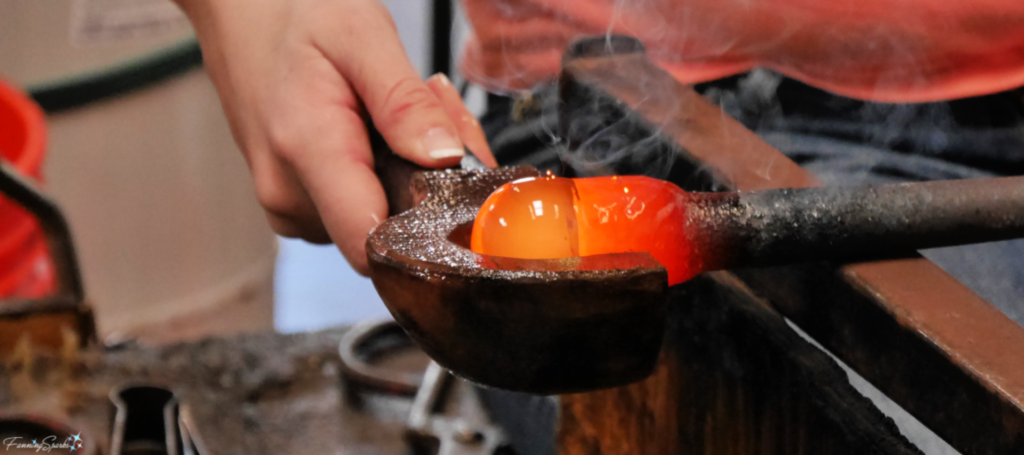Gilbert Glassworks, in Santa Rosa Beach, Florida, recently started offering a series of workshops on glassmaking. I had the good fortune to attend their Glassblowing Fundamentals workshop which focused on hot glass techniques. And, yes, at 2000 degrees Fahrenheit, that’s HOT! They’re not kidding when they say “This is a true “hot glass” experience”. It was fantastic‒authentic and exhilarating!
I knew there were different ways of making glass but didn’t quite appreciate the variety and significance. In researching for this post, I found this basic explanation from Bernard Katz (see More Info below) very helpful. He groups common ways of making glass art into 4 categories: Hot Glass, Warm Glass, Cold Glass and Lampworking.
1. Hot glass involves working with molten glass (with a temperature around 2000° F/ about 1100° C). Three primary methods are used glass blowing, glass sculpting and casting into molds. Here’s an example of some finished pieces.

2. Warm glass involves heating glass in an oven or kiln. Slumping and fusing are common warm glass techniques. In slumping, sheet glass is placed onto a mold and heated to a temperature between 1250° – 1400° F, to melt and bend with gravity. Fusing, typically done with a temperature between 1400° – 1600° F, is used to melt together pieces of glass. Slumping was used to form this coral-patterned bowl.
 This pretty plaque was created with glass fusing.
This pretty plaque was created with glass fusing.
 3. Cold glass techniques include grinding, polishing, etching, and engraving. According to Wikipedia, traditional stained glass work and lead crystal also fit in this category. Lead crystal, such as the well-known Waterford Crystal, is made by cutting glass with a diamond saw, or copper wheels embedded with abrasives, and polishing it to give gleaming facets.
3. Cold glass techniques include grinding, polishing, etching, and engraving. According to Wikipedia, traditional stained glass work and lead crystal also fit in this category. Lead crystal, such as the well-known Waterford Crystal, is made by cutting glass with a diamond saw, or copper wheels embedded with abrasives, and polishing it to give gleaming facets.
4. In Lampworking, or flame working, the artist heats glass tubing or glass rods with a torch to then blow and sculpt beads, ornaments and other small figurines. This beautiful example of lampwork was created by Russ Gilbert, the owner of Gilbert Glassworks.

Interestingly, there appears to be a distinction between the terms “glass art” and “art glass”. “Glass art” seems to be used more broadly and encompasses individual works of art that are substantially or wholly made of glass. “Art glass”, on the other hand, seems to be used more narrowly to describe small decorative works made of glass.
So… back to the Gilbert Glassworks workshop. This experience is not to be taken lightly. Students spend 3+ hours in the midst of a working glass studio surrounded by sharp and crazy-hot materials. It’s critical to listen attentively to the safety instructions and follow them carefully. This is not your typical “Stand behind the rope, don’t touch anything and let us dazzle you!” kind of demonstration. Stay alert and prepare to be amazed. Here’s a case in point, one of my fellow students is using a torch to activate the color in his glass piece.

The Gilbert Glassworks’ website refers to this workshop as “Furnace Glass” and explains: “This is what is normally referred to as ‘traditional’ glasswork. Utilizing a furnace full of glass and a glory hole to re-heat your work, a steel pipe or rod is dipped in the furnace, picking up a “gather” of glass. Then a multitude of tools, air and gravity are used to manipulate and shape the glass, creating a work of art. Re-heating the glass in the glory hole is necessary to maintain the heat needed to shape and mold the final piece. There are a great number of methods and techniques used to add color, shape, and texture.”
Students actually create their own glass sculpture under the watchful eye and constant guidance of experienced glass artists, Russ and Brit. During the workshop, I had the opportunity to experience a number of the glassworking steps. Here are some examples. We learned to constantly turn the steel rod to maintain the shape of the molten glass.

It’s amazing how flexible the glass is when it’s hot. But it cools off very quickly and you have to work swiftly. We learned the glass needs to be re-heated repeatedly. Here’s the glass being re-heated in the glory hole.

We learned to use a wet, wooden block to shape and smooth our glass piece. This is our instructor, Brit, demonstrating the technique.

In the below photo, a student is rolling her glass in glass frit to add color to the piece.

We used a thick felt pad, soaked in water, to further smooth our glass.

We marked our glass with jacks. We cut our glass with shears. We experienced numerous captivating tasks. And, yes, we even had a chance to try to blow a bubble into our glass. Blowing glass, it turns out, is not as easy as it sounds! There’s a lot more to it than simply blowing into the tube.
As I learn more about the art of glassmaking, I have a better appreciation for the two glass artist studios I visited on the Henderson County Open Studio Tour. See my post, Peeking Behind the Studio Curtain, for more info. Cat Martin’s studio, which I featured in the post, focuses on warm glass techniques such as slumping and fusing glass. You may recall, I used Cat’s glass pieces to embellish a woven statement necklace for the holidays (Add a Little Sparkle).

I visited a second glass studio on the Henderson County Open Studio Tour. Suzanne Cancilla-Fox focuses on lampworking. This rainbow of glass rods at her studio caught my eye.

This next photo shows Russ doing some flamework at Gilbert Glassworks. I assume this is the method he would have used to create that gorgeous dolphin sculpture pictured earlier in this post. Impressive, eh?

Russ is a highly-regarded glassmaker known for naturalist styles and themes. He’s spent a lifetime (well…since 1979) perfecting his craft and it shows‒his work is beautiful and innovative. Russ is also a gallery owner. His gallery, Fusion Art Glass Gallery, has two locations. The first location is in Seaside, Florida and the second location is in Sandestin, Florida .
In writing this post, I came across a quote from Russ regarding the joy of creating. He said “There’s nothing and then there’s something. That’s the hook‒the passion, the creation, the possibility of what you can make.”. Perfectly stated!
It’s obvious Russ is passionate about the art of glassmaking. Not only is he an accomplished glassmaker himself, he supports other glassmakers through his galleries and now he makes it possible for anyone with an interest to experience the joy of glassmaking at Gilbert Glassworks. Many thanks to Russ and Brit for a great workshop experience!
More Info
Learn more about the Gilbert Glassworks workshops and the Fusion Art Glass galleries.
This VIE Magazine article from Sept/Oct 2016, From Ashes to Beauty, is an interesting read about Russ Gilbert and the art of glassblowing.
Here’s the link to Bernard Katz’s web page on how art glass is made.
The Corning Museum of Glass website has lots of interesting information including this explanation of the tools of the glassmaker. By the way, the Corning Museum of Glass, located in Corning, New York, claims to house the world’s most comprehensive collection of glass with nearly 50,000 objects representing more than 3,500 years of history.
See my post, Peeking Behind the Studio Curtain, for information about the Henderson County Open Studio Tour held in North Carolina every fall. You can contact the two glass artists mentioned in this post via email at Cat Martin or Suzanne Cancilla-Fox. See my post, Add a Little Sparkle, for more of Cat’s work.
Today’s Takeaways
1 Explore the possibility of hands-on glassmaking through workshops hosted by local glass artists.
2 Seek opportunities to admire and study the work of professional artists. Show your support through the purchase of their work.
3 Consider the joy of creating as described by Russ Gilbert “There’s nothing and then there’s something. That’s the hook‒the passion, the creation, the possibility of what you can make.”.





Comments are closed.